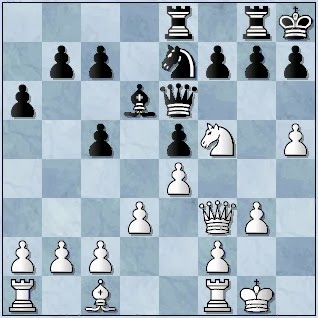This is the solution to the puzzle from ETTC 2007 i published on 07 Nov. I will come back to this solution to make it more lucid for my own improvement sake!
#1
White to move
Alexander Morozevich 2755 - Vladislav Tkachiev 2661, EuroTeams 2007 [Russia-France].
Knight at a7 is hanging but black cannot take it since there is a pin to his rook at b6. In this position, how we wish that a pawn would be at c2 so c4 force the exchange. Anyway, when where there is a pin, whenever possible, it is customary to streghten the burden on the attacked piece so extra material advantage can be gained from such course of action. So, what piece can futher attack the knight at b5? Yeah, bishop! At what square? c4! So,
Bd5! and threaten Bc4. Note that attack from c6 by Bc6 lead to equality since black can reply Ra6. So, after Bd5, black resigned.
#2
Black to move
Martin Neubauer 2453 - Gabriel Sargissian 2673, EuroTeams 2007 [Austria-Armenia].
The problem with white position is that, firstly, his King is too far away to protect his own pawns and secondly, his pawns at queen side are on dark squares. Black should attack pawn at b2. So,
Kc6! 39. Kg2 (Be3)
Kxc5 40. Kf2 Kc4 41. Ke2 Kb3 and white resigned.
#3
White to move
Maxim Rodshtein 2615 - Claude Landenbergue 2452, EuroTeams 2007 [Israel-Switzerland].
Here, of course everyone see the common idea of forking, Nc7+. Unfortunately, the square is well guarded by knight at e6. Only if we can remove the knight! And yes, only if we can prevent the knight from doing that job!! Futher examination shows that with our knight at e5, f7 can be attacked and black bishop at b5 can give us one tempo.
18. Qb3! Qa6 19. Nc7+! The knight at e6 cannot take at c7 since Qxf7+ is deadly and mate in few moves!
#4
White to move
Alexander Areshchenko 2638 - Maxim Rodshtein 2615, EuroTeams 2007 [Ukraine-Israel].
This is relatively difficult puzzle. Although black position looks under severe attack, but it has lot of resources to defence: Q at c6, B at h7, pawn at f7, B at e7 etc. Sequence like Nf5+ Bxf5 Qxf5 Qg6 or e6 fxe6 or Ng4 Qg6 won’t help white. Anyway, when examine Nf5+ (with the idea of forking King and bishop at e7 which guard the Knight at c5), how we wish that no bishop at h7 to guard f5 square. And how we wish that our knight at f3 not at that square but at d4!. Nd4 straight away make us lose our knight at h6 Qxh6. Yeah, the key to it is “intermediate move”!
Nf5+ The only move to win!
Bxf5 Nd4! Attack the queen and then Nxf5 forking the King and bishop while rook at c1 attack the knight at c5!
#5
White to move
Peter Svidler 2732 - Ivan Cheparinov 2670, EuroTeams 2007 [Russia-Bulgaria].
Bc5! cutting the King from hiding to King’s side and open the e-files for rook at h1. After Bc5, black simply lose. Taking the bishop, for example will lead to mate. In the game, black played
Qb3 and it continue:
Re5+ Kd8 Bxb4 Qxb4 Rc1 and black resigned.
#6
In this position, black moved 26. .. Rc8 which is inaccurate.
How should white punish the black inaccuracy?
Levan Pantsulaia 2617 - Stefan Kristjansson 2458, EuroTeams 2007. [Georgia-Iceland].
This is a simple tactic. After black Rc8, black only help white to remove one defender of Knight at e5 so the battery Q at a1 and B at b2 become powerful now.
27.Rxc8 Qxc8 28.Nxb5! win a pawn. The game continue:
28. … axb5 29. Bxe5 Bxe5 30.Qxe5 Qc1+ 31.Bf1 Qxa3 32.Qxb5 and white then push his b-passed pawn and black resigned at moves 44.
#7
White to move
Shakhriyar Mamedyarov 2752 - Mikhail Gurevich 2627, EuroTeams 2007 [Azerbaijan-Turkey].
30. Rhg1! is the clean way to finish it. The game continue:
Qd6 31. Re6 and black resigned.
#8
White to move
Gabriel Sargissian 2673- Constantin Lupulescu 2562, EuroTeams 2007 [Armenia-Romania].
White is a rook down but 2 pawns up. As compensation, white has more space and its pawn chain looks great. It is very tempting to push pawn e5 but this cannot be done straightaway: 35. e5 Bxe5 36. Re1 f6 and black is OK. If we start to support the pawn first by 35.Re1, then Be5 can stop white attack. A microscopic eyes will observe that after e5 Bxe5, it clears ways for Q at b6 to move to h6 and only if a piece will support it at h6, the life will be great. So, instead of support the pawn by Re1,
35. Rh1! prepares for the e5 attack and the only way to maintain the initiative. After intense struggle, black resigned at move 57.





























